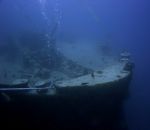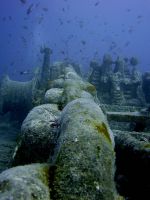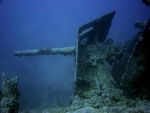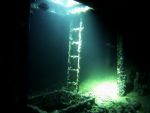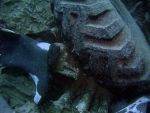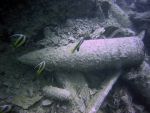Articles
Thistlegorm
11-9-2009
Two thirds of earth´s surface are created by seas and oceans. These places hide many secrets which have been waiting for their discovering. The bottom of the seas is besprinkled by many wrecks from different periods: from the beginning of sea voyages, over boats from the Middle age to nowadays boats. Lots of them come from the Second World War as the Thistlegorm.The Thistlegorm was a medium-sized shopping boat with a displacement 4898 tonnes. She was built in J. L. Thompson & Sons docks in 1940 and was intended for Albyn Line. Was named Thistlegorm as the last boat from series beginning with Thistle-. Under the lead of captain Whiffilde 49 sailors were engaged there. 9.4.1940 she was suit to war for army use. From the beginning of her services she was pursue by a bad luck, already during the second voyage, on the river Plata, happened an accident with an anti-aircraft 4,7 inch cannon, during the test a charge got stuck in it and they had to shoot it, the charge fell down to water near the boat. The third voyage was to west India with a cargo of sugar and rum, during the journey there was problem with steam cauldron and the ship had to be repaired for two months in Glasgow.
The fourth passage should be last for army. Boat was loaded with ammunition, hand shells, cars, motorbikes, tanks, railway set and another army material. The cargo aimed for the allied forces in North Africa, but the way to the Mediterranean Sea was closed for allied ships, so the route was around whole the African continent and across the Red Sea. The Thistlegorm was anchored in the area Sh´ab Ali in the Red Sea and was waiting for the permission to sail the Suez Canal. At the same time two Germany bombers type Heinekel He 111 air squadron 11/KG26 took of from Crete, whose mission was to sink the ship Queen Marry, that was then in the Red Sea with 12 000 Australian soldiers aboand and the north African front. As the weather was not good and of communicate the pilots bad, they didn’t locate their target so they were coming back. When they were flying across the Suez Canal they saw the anchoring ship and they decided to throw down the bombs originally aimed for the ,,Queen Marry”… The anchoring ship was the Thistlegorm still waiting for the permission. At two o’clock in the morning on 6thOctober 1941, the day before unloading, she was hit with two bombs, one was dropped into the ammunition store and the explosion tore the boat into two parts. She immediately started to sink, nor 10 minutes the sea deep compressed her into it´s arms. The Thistlegorm was in a bad time on a bad place. The crew was rescued by the near anchoring HMS Carlisle, died 9 people. Even the German pilots did not rescue without punishment, over the Mediterranean Sea they were shot down and till the end of the war they were imprisoned . When the Thistlegorm was sinking one of the members of the crew – Angus McLeay – bravely sacrificed his life for saving a sailor who was lying under a big anchor wind. He was awared Georges and Lloyd’s war medal for bravely in the sea in memoriam.
Despite her varied past the Thistlegorm was unknown, her wreck have been for many years only a shelter for sea animals- especially for big groupers (which are under a big screw propeller in the depth of 31m), barracudas, which are in big shoals in currents around the wreck, end even for other big fish like trevallies, batfish and snappers. Inside the wreck and under different plates there are big murenas and eels. Often you discover naked branched slugs as pyjama slug, varicose wart slug and bighorn nembrotha. Occasionally you meet Napoleon fish or even a dolphin or shark.
Many divers from all over the world go there to get acquainted with the history and magic of this wreck. The Thistlegorm is 126m long and 17,5m wide. The Deck is in the depth of 17m and the keel in 30m, so the wreck is available for recreation divers. Divers have to descend using descended ropes bound to the wreck because there are often currents, and due to only a little inattention and you can be brought far away from the wreck and your diving boat. During your descending a silhouette of the wreck is turning up in front of you slowly, it’s a marvellous view. Successively you can distinguish form and it´s single parts. On the front deck there is a big anchor wind. If you follow the anchor chain to the edge of the wreck, you’ll see it hang down on to the bottom of the sea all the time - the wreck is still anchored as it used to be once. In the centre of the explosion you can see tanks turned upsite down, ammunition, rackets and lorries. In the Thistlegorm you can find war heads, which did not explode . That is why you have to be careful. About 20m far from the left side there was by the explosion a locomotive shut up, which was a part of the railway set aimed to Africa. On the stern there are two canons and a gigantic screw propeller. If you want to go into the wreck you must have some experience, knowledge and follow the rules of safe diving. Your attention will be drawn by army cars, motorbikes and other army material: footwear, clothes, tools, spare parts and engines to planes.
Not always aid the Thistlegorm this favour. Several months after she had sunk nobody knew about her. On 1952 she was discovered enjory by world-known Jacques Cousteau on the ship Calypso during his voyages round the Red Sea. Cousteau was afraid of about the wreck’s future because of adventurers and plungerers, so he on purpose gave bad information on her last rest place . So the Thistlegorm was forgotten again. Nobody knew about her until 1992, when she was again discovered. From at time is the Thistlegorm the most much-sought and the most popular wreck in the Red Sea. It became a target for many sport and recreation divers from all over the world.
back


